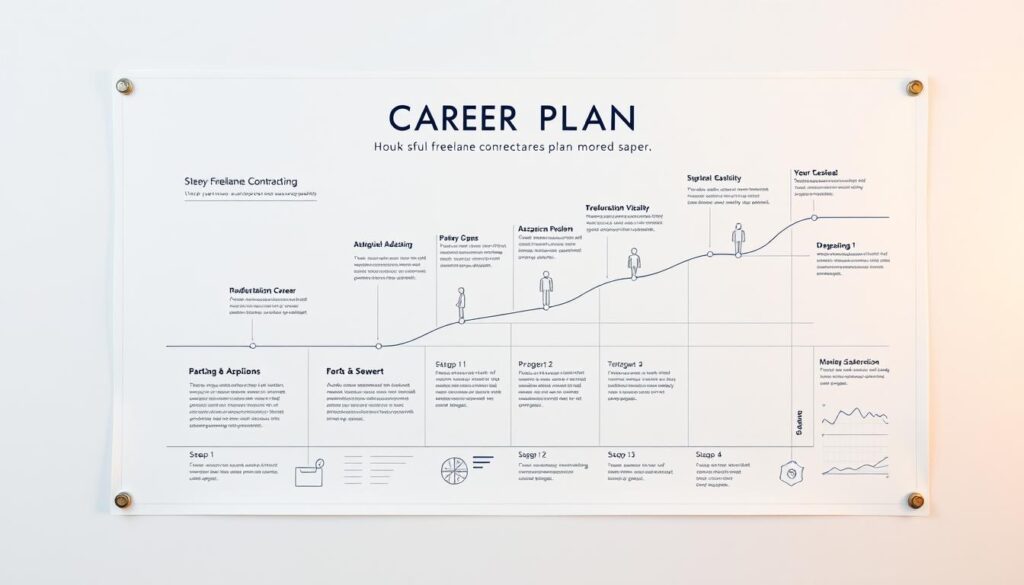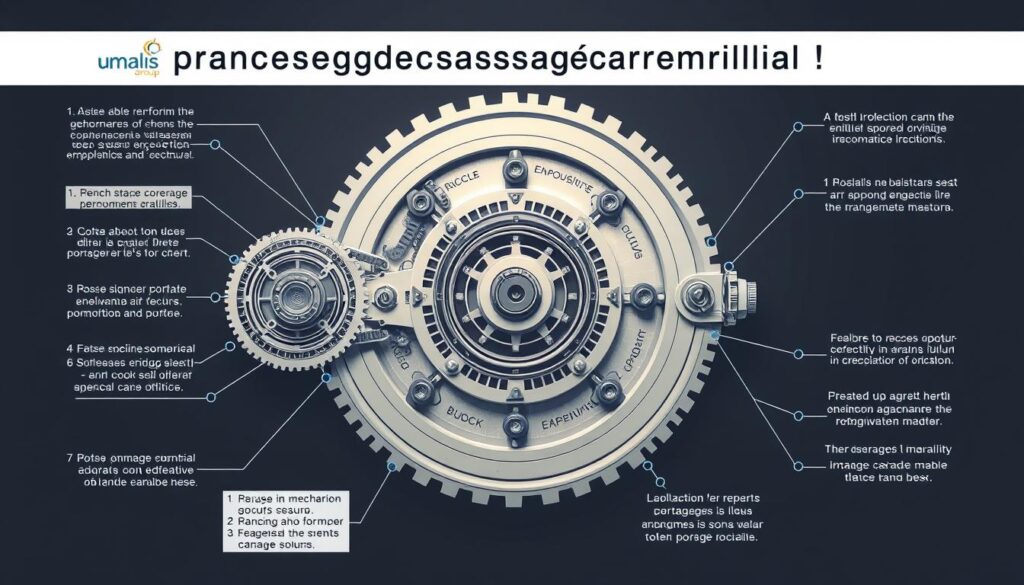Vous vous souvenez de cette sensation? Celle qui vous étreint lorsque vous découvrez un appel d’offres parfaitement aligné avec votre expertise, mais que l’ampleur des formalités administratives vous fait hésiter. Cette opportunité qui pourrait propulser votre activité de consultant indépendant semble soudain hors de portée.
Nous comprenons ce découragement. Rassembler les pièces, garantir votre conformité, et présenter une candidature solide demande un temps précieux que vous préféreriez consacrer à votre cœur de métier. C’est précisément à ce défi que le portage salarial apporte une réponse structurante et sécurisante.
Ce dispositif intelligent transforme une procédure souvent perçue comme complexe en une démarche accessible. Il vous permet de vous concentrer sur l’essentiel : valoriser votre savoir-faire unique pour décrocher des missions d’envergure.
Nous vous guidons ici pour exploiter tout le potentiel de cette solution. Vous apprendrez à construire une réponse persuasive qui marque les esprits, tant sur les marchés publics que privés. L’objectif est clair : transformer ces opportunités en succès concrets et durables pour votre carrière de freelance.
Points clés à retenir
- Le portage salarial simplifie considérablement la réponse aux appels d’offres en gérant le volet administratif.
- Il renforce votre crédibilité face aux donneurs d’ordres grâce à un cadre juridique sécurisé.
- Cette solution est adaptée pour répondre à la fois aux marchés publics et privés.
- Une réponse pertinente doit mettre en avant votre expertise spécifique et votre valeur ajoutée.
- L’accompagnement d’une société de portage multiplie vos chances de remporter des missions importantes.
- Cette approche vous aide à développer un portefeuille clients diversifié et pérenne.
Comprendre les appels d’offres dans le portage salarial
Le succès dans la réponse aux consultations passe d’abord par une compréhension approfondie de leur fonctionnement. Cette connaissance vous permet d’identifier les opportunités les plus adaptées à votre profil.
Définition et objectifs
Un appel d’offres constitue une procédure formelle permettant à un donneur d’ordre de solliciter des propositions. L’objectif principal est d’assurer une concurrence équitable entre les candidats.
Cette démarche garantit la transparence dans le choix du prestataire. Elle permet au client de comparer différentes solutions proposées.
Les différences entre marchés publics et privés
Les marchés publics suivent des règles strictes de mise en concurrence. Pour les projets supérieurs à 25 000 € HT, cette procédure est obligatoire.
Dans le secteur privé, les entreprises bénéficient d’une plus grande flexibilité. Elles peuvent contacter directement des prestataires sans obligation de consultation publique.
| Critère | Marchés publics | Marchés privés |
|---|---|---|
| Obligation de mise en concurrence | Obligatoire au-dessus de 25 000 € HT | Non obligatoire |
| Sources d’information | BOAMP, JOUE, sites des collectivités | Réseaux professionnels, appels directs |
| Flexibilité des critères | Critères fixes dans le règlement | Plus grande adaptabilité |
| Transparence requise | Élevée, procédure encadrée | Variable selon l’entreprise |
Cette distinction fondamentale influence votre stratégie de réponse. Elle détermine également les canaux à surveiller pour identifier de nouvelles opportunités.
L’importance du portage salarial pour les consultants indépendants
La sécurité juridique et financière demeure une préoccupation centrale pour les travailleurs autonomes. Le portage salarial répond précisément à ce besoin en offrant un cadre structurant qui protège votre activité.

Sécurisation juridique et financière
Votre société de portage salarial devient un partenaire stratégique. Elle garantit votre conformité légale et votre solvabilité auprès des clients.
Les avantages sont multiples. Vous bénéficiez du statut de salarié tout en conservant votre autonomie professionnelle. Cette double casquette renforce considérablement votre crédibilité.
L’accompagnement personnalisé fait toute la différence. Votre chargé d’affaires maîtrise les exigences des consultations complexes. Il vous guide dans la préparation de réponses pertinentes.
Cette solution vous ouvre l’accès à des missions importantes. Les donneurs d’ordre valorisent la stabilité institutionnelle offerte par une société spécialisée. Votre proposition gagne en poids face à la concurrence.
La gestion des aspects administratifs est entièrement prise en charge. Vous pouvez ainsi vous concentrer sur votre expertise métier. Les cotisations sociales et autres formalités sont assurées par des professionnels.
Le portage facilite également les collaborations entre consultants. Vous pouvez constituer des équipes pluridisciplinaires pour répondre à des projets ambitieux. Cette flexibilité élargit votre champ d’action.
En résumé, ce dispositif offre une tranquillité d’esprit précieuse. Vous développez votre activité avec confiance, soutenu par une structure solide. Vos services gagnent en valeur perçue sur le marché.
Préparer une candidature solide aux appels d’offres
Avant de rédiger votre réponse, investissez le temps nécessaire pour comprendre parfaitement les attentes du client. Cette phase préparatoire constitue la base d’une proposition pertinente.
Analyse du cahier des charges
Le document fourni par l’acheteur détaille tous les besoins spécifiques. Une lecture attentive vous permet d’identifier les exigences techniques et les contraintes temporelles.
| Aspect à analyser | Objectif | Outils recommandés |
|---|---|---|
| Exigences techniques | Vérifier l’adéquation avec vos compétences | Tableau de correspondance |
| Critères d’évaluation | Comprendre les priorités du client | Grille d’analyse pondérée |
| Contraintes temporelles | Évaluer votre disponibilité réelle | Planning détaillé |
| Budget indicatif | Adapter votre proposition financière | Étude de faisabilité |
Identification des compétences et ressources
Évaluez objectivement vos compétences disponibles pour cette prestation. Notre principal conseil est de créer un inventaire détaillé de vos ressources.
Cette évaluation inclut votre disponibilité et votre expertise technique. Pour les projets complexes, le portage salarial comme solution de flexibilité vous permet de mobiliser des compétences complémentaires.
Le travail d’identification peut révéler des points à renforcer. Cette démarche vous aide à constituer une équipe adaptée aux besoins des entreprises clientes.
Comment répondre efficacement aux appels d’offres en portage salarial
Transformer la complexité administrative en avantage concurrentiel nécessite une démarche organisée. Nous vous présentons ici une méthodologie éprouvée pour construire des réponses pertinentes.
Étapes clés de la démarche
La première phase consiste à rassembler les documents administratifs requis. Votre société de portage vous fournit les attestations essentielles comme les formulaires DC1 à DC4.

L’élaboration du mémoire technique représente l’étape centrale. Ce document démontre votre compréhension des enjeux et votre méthodologie d’intervention.
L’acte d’engagement finalise votre proposition. Il formalise votre engagement sur les délais et modalités financières.
Votre chargé d’affaires coordonne l’ensemble du processus. Il vérifie la conformité administrative et assure le respect des délais.
Cette approche structurée permet aux consultants de se concentrer sur leur expertise. Ils transforment ainsi les contraintes administratives en véritables opportunités de développement.
Les missions complexes deviennent accessibles grâce à cette méthodologie. Votre réponse gagne en crédibilité et pertinence.
Rédiger une réponse percutante et structurée
L’impact visuel et rédactionnel de votre offre influence directement la perception de votre expertise. Votre document représente votre premier contact professionnel avec le décideur.
Une présentation soignée démontre immédiatement votre sérieux. Elle facilite également la lecture et la compréhension de votre proposition.
Choisir le bon langage et la mise en forme
Votre réponse doit être adaptée au profil des lecteurs. Privilégiez un style simple et accessible pour tous.
Évitez le jargon technique non expliqué. Les acronymes nécessitent une définition claire. Votre document sera évalué par des profils variés.
La mise en page joue un rôle crucial. Utilisez une typographie lisible et aérée. Les titres explicites guident naturellement le lecteur.
Intégrez des éléments visuels pertinents. Tableaux et graphiques synthétiques facilitent la compréhension. Un sommaire paginé permet une navigation intuitive.
Mise en avant de l’expertise et des références
Votre expertise constitue un élément différenciant majeur. Présentez-la stratégiquement selon les exigences du cahier des charges.
Dans chaque cas, personnalisez votre offre. Démontrez votre compréhension des enjeux spécifiques. Évitez les propositions génériques.
Les références clients renforcent votre crédibilité. Placez-les dans le corps du document si demandé. Sinon, ajoutez-les en annexe pour ne pas alourdir la lecture.
| Élément clé | Objectif | Recommandation | Impact |
|---|---|---|---|
| Langage adapté | Accessibilité pour tous les profils | Style simple, définitions claires | Meilleure compréhension |
| Structure logique | Guidage du lecteur | Sommaire paginé, titres explicites | Navigation intuitive |
| Visuels pertinents | Illustration concrète | Graphiques, tableaux synthétiques | Compréhension facilitée |
| Personnalisation | Démonstration d’adaptation | Réponse spécifique au projet | Différenciation positive |
Cette approche structurée maximise l’impact de votre candidature. Elle positionne favorablement votre proposition face à la concurrence.
Optimiser l’offre commerciale et la proposition de prix
L’élaboration de votre offre commerciale représente une étape décisive dans votre réponse. Elle doit concilier attractivité économique et juste valorisation de votre expertise.
Nous vous accompagnons dans cette réflexion stratégique. Votre proposition gagne en crédibilité lorsqu’elle démontre une compréhension fine des attentes client.
Valorisation des avantages concurrentiels
Votre prix communique immédiatement votre positionnement. Un tarif trop bas peut questionner votre professionnalisme.
À l’inverse, une valorisation excessive risque d’écarter votre candidature. L’équilibre parfait réside dans la transparence.

Décomposez clairement chaque poste de fraises. Journées de travail, déplacements et services annexes méritent une ligne distincte.
Cette approche facilite la comparaison par le comité. Elle démontre votre rigueur et votre honnêteté commerciale.
Transparence sur les coûts et les délais
La clarté sur les délais renforce la confiance. Présentez un calendrier détaillé avec des jalons intermédiaires.
Votre planning doit être réaliste et engageant. Il montre votre capacité à respecter le contrat dans les temps.
Intégrez un tableau exhaustif en annexe. Cette synthèse visuelle accélère l’évaluation de votre proposition.
| Élément de prix | Présentation recommandée | Impact sur l’évaluateur | Positionnement idéal |
|---|---|---|---|
| Tarif journalier | Détail compétences incluses | Compréhension valeur | Après démonstration expertise |
| Fraises annexes | Liste exhaustive et justifiée | Transparence appréciée | En annexe détaillée |
| Délais réalisation | Jalons intermédiaires précis | Réassurance capacité | Avant proposition financière |
| Solutions alternatives | Options avec impact budget | Flexibilité valorisée | En fin de document |
Cette structure maximise vos chances d’intégrer la short list. Les bénéfices de votre prestation apparaissent clairement.
L’effet professionnel produit par cette méthode impressionne les acheteurs exigeants. Vos offres gagnent en pertinence et en compétitivité.
Exploiter la démarche marketing pour trouver de nouveaux clients
La recherche de nouveaux clients nécessite une vision globale intégrant prospection et analyse du marché. Votre activité de consultant gagne en pérennité lorsque vous dépassez la simple réponse aux consultations.
Nous vous accompagnons dans cette approche stratégique. Elle transforme les opportunités ponctuelles en leviers de croissance durable.
Pré-analyse commerciale et veille concurrentielle
Identifier les entreprises susceptibles de lancer des consultations correspond à votre expertise. Cette anticipation vous positionne comme interlocuteur de référence.
La veille de la concurrence révèle leurs arguments et positionnements. Vous pouvez ainsi différencier votre proposition avec une valeur distinctive.
Rencontre et entretien avec l’acheteur
Lorsque possible, sollicitez un échange direct avec le donneur d’ordre. Cette rencontre découvre ses motivations réelles et attentes implicites.
Votre chargé d’affaires facilite cette prospection stratégique. Il vous aide à trouver les clients pertinents dans son réseau professionnel.
Même sans remporter la consultation, une réponse de qualité fait connaître votre offre. Elle ouvre la porte à de futures collaborations.
Conclusion
Maîtriser l’art de la réponse aux demandes de prestations constitue un atout déterminant pour votre développement. Cette compétence stratégique ouvre l’accès à des missions prestigieuses dans divers secteurs d’activité.
Le portage salarial se révèle être votre allié précieux. Il maximise vos chances de succès en combinant votre expertise avec un cadre sécurisant. Votre statut de salarié porté renforce immédiatement votre crédibilité.
Chaque réponse représente une opportunité de croissance. Même sans remporter le contrat, vous faites connaître votre travail auprès de nouveaux clients potentiels.
Nous vous encourageons à adopter cette approche proactive. En appliquant ces principes, vous transformerez les consultations en leviers de croissance pour votre activité de consultant indépendant. Votre réussite repose sur la compréhension du besoin client et la démonstration de votre valeur unique.
Votre société de portage reste à vos côtés pour concrétiser vos projets professionnels les plus ambitieux. Ensemble, bâtissons votre avenir de freelance performant.
FAQ
Le portage salarial est-il adapté pour répondre à tous les types d’appels d’offres ?
Le portage salarial convient particulièrement bien aux appels d’offres émanant d’entreprises privées et pour des missions de conseil ou d’expertise. Pour les marchés publics, la situation peut être plus complexe et dépend des règles spécifiques de chaque consultation. Votre société de portage peut vous aider à analyser la faisabilité.
Comment une société de portage salarial peut-elle augmenter mes chances de remporter un appel d’offres ?
Notre société vous apporte un cadre sécurisé qui rassure le client. Nous gérons l’aspect administratif et juridique, ce qui vous permet de vous concentrer sur la démonstration de votre expertise et la qualité de votre prestation. Cet avantage est un vrai bénéfice face à la concurrence.
Dois-je adapter mon prix lorsque je réponds à une offre via le portage salarial ?
Oui, votre proposition de prix doit intégrer les frais de gestion de la société de portage. L’important est d’être transparent avec votre client potentiel sur la répartition des coûts. Cette honnêteté valorise votre offre et renforce la confiance.
Quels sont les avantages principaux du portage salarial pour un consultant qui répond à des appels d’offres ?
Les avantages sont multiples : statut de salarié pour une sécurité juridique, support administratif, et simplification de la facturation. Cela vous permet de concourir sur des marchés plus importants et de gagner du temps pour vous consacrer à votre cœur de métier.
Comment bien préparer la rencontre avec l’acheteur après avoir répondu à un appel d’offres ?
Préparez cette rencontre en anticipant les besoins du client et en mettant en avant comment votre expertise répond précisément à son problème. Maîtrisez parfaitement les détails de votre offre et soyez prêt à discuter des bénéfices concrets de votre mission.





































